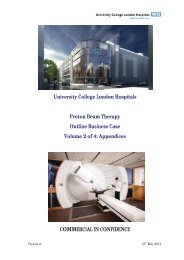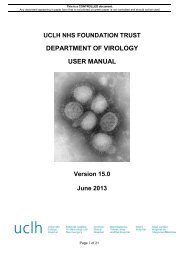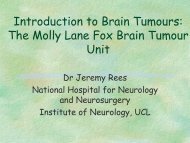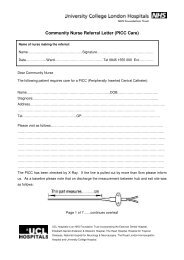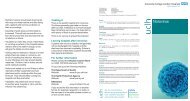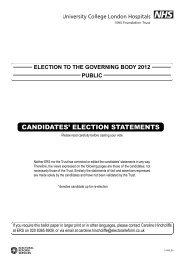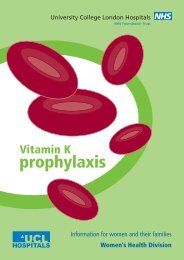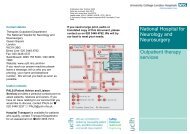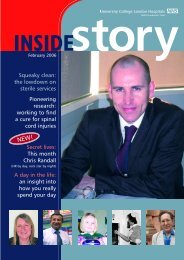How patients have helped us with our research - University College ...
How patients have helped us with our research - University College ...
How patients have helped us with our research - University College ...
Create successful ePaper yourself
Turn your PDF publications into a flip-book with our unique Google optimized e-Paper software.
<strong>How</strong> <strong>patients</strong> <strong>have</strong> <strong>helped</strong><br />
<strong>us</strong> <strong>with</strong> <strong>our</strong> <strong>research</strong><br />
UCLH/UCL nihr Comprehensive Biomedical Research Centre
2 UCLH BIOMEDICAL RESEARCH UNIT<br />
Contents<br />
Welcome 1<br />
Patients help design <strong>research</strong> studies 2<br />
Joining forces to pioneer gene therapy 4<br />
Community representatives ensure success of HIV database 6<br />
Community groups make sure genetic cancer screening<br />
study happens 8<br />
Website helps brain injured <strong>patients</strong> read 10<br />
Patients find new ways of describing pain 12<br />
Patients advise on best way of doing prostate <strong>research</strong> 14
PATIENT CASE STUDIES 31<br />
Welcome<br />
This booklet describes<br />
some of the many ways that<br />
<strong>patients</strong> <strong>have</strong> got involved<br />
in biomedical <strong>research</strong> at<br />
<strong>University</strong> <strong>College</strong> London<br />
Hospitals (UCLH) and<br />
<strong>University</strong> <strong>College</strong> London<br />
(UCL).<br />
By patient involvement<br />
in <strong>research</strong> we mean an<br />
active partnership between<br />
<strong>patients</strong> and <strong>research</strong>ers<br />
where <strong>patients</strong> help design<br />
and carry out <strong>research</strong><br />
studies.<br />
We hope the following<br />
pages will inspire people<br />
to find out more about <strong>our</strong><br />
<strong>research</strong> and perhaps even to<br />
get involved.<br />
Foreword by Professor<br />
Deenan Pillay<br />
Here at <strong>University</strong> <strong>College</strong><br />
London Hospitals (UCLH) and<br />
<strong>University</strong> <strong>College</strong> London (UCL)<br />
we <strong>have</strong> formed a partnership<br />
called the Comprehensive<br />
Biomedical Research Centre<br />
to make sure that exciting<br />
advances in science are applied<br />
as quickly as possible in<br />
healthcare.<br />
Doctors, nurses and <strong>research</strong>ers<br />
work closely <strong>with</strong> scientists<br />
to make sure advances in<br />
medical <strong>research</strong> <strong>have</strong> a direct<br />
impact on patient care and<br />
quality of life, as well as saving<br />
many lives.<br />
But what people often don’t<br />
realise is that <strong>patients</strong> and<br />
members of the community<br />
play a key role in <strong>our</strong> success.<br />
Patients and the public are <strong>our</strong><br />
partners.<br />
We work closely <strong>with</strong> <strong>patients</strong><br />
and the public to make sure<br />
that what we are doing<br />
is relevant to their needs,<br />
appropriate and effective.<br />
We need to know we are<br />
asking the right questions and<br />
<strong>us</strong>ing the right processes. We<br />
need to know we are <strong>us</strong>ing the<br />
right language and reaching the<br />
right people.<br />
Here are j<strong>us</strong>t a few examples<br />
of the many ways <strong>patients</strong><br />
and community members<br />
<strong>have</strong> worked <strong>with</strong> <strong>us</strong> to make<br />
sure <strong>our</strong> <strong>research</strong> leads to real<br />
improvements in healthcare.<br />
Professor Deenan Pillay,<br />
Director, UCLH/UCL National<br />
Institute for Health Research<br />
Comprehensive Biomedical<br />
Research Centre
2<br />
Patients help design <strong>research</strong> studies<br />
Patients and community<br />
groups <strong>have</strong> been working so<br />
successfully <strong>with</strong> reproductive<br />
health <strong>research</strong>ers at the<br />
<strong>University</strong> <strong>College</strong> London (UCL)<br />
Institute of Women’s Health<br />
based at the Margaret Pyke<br />
Centre, that they now actually<br />
help shape and design <strong>research</strong><br />
studies.<br />
What began as a patient/public<br />
participation group to improve<br />
things like communication of<br />
the centre’s <strong>research</strong> findings<br />
has now become a Research<br />
and Innovation Forum, <strong>with</strong><br />
40 lay members including<br />
<strong>patients</strong>, local residents<br />
and representatives of local<br />
community groups.<br />
Patients now <strong>have</strong> a much<br />
greater input into <strong>research</strong> on<br />
contraception and reproductive<br />
sexual health. They don’t<br />
j<strong>us</strong>t comment on <strong>research</strong><br />
proposals. In some cases they<br />
are actually a ‘co-applicant’<br />
<strong>with</strong> <strong>research</strong>ers.<br />
<strong>How</strong> the <strong>research</strong><br />
forum works<br />
The Research and Innovation<br />
Forum, which was set up <strong>with</strong><br />
funding from a UCL Public<br />
Engagement Beacon Bursary,<br />
meets regularly to help develop<br />
<strong>research</strong> proposals and funding<br />
applications.<br />
Researchers tell forum members<br />
about their work and ideas for<br />
the future. In turn the members<br />
will comment and offer<br />
suggestions and constructive<br />
criticism on <strong>research</strong> studies.<br />
This is an important way of<br />
making sure <strong>research</strong> is relevant<br />
to the needs of <strong>patients</strong> and the<br />
community. Members review<br />
information such as patient<br />
information sheets and consent<br />
forms to make sure that<br />
information is clear and easy<br />
to understand.<br />
The group also looks at<br />
procedures in clinical trials and<br />
advises <strong>research</strong>ers on whether<br />
these will be acceptable<br />
to <strong>patients</strong>. Members<br />
help disseminate <strong>research</strong><br />
study findings and improve<br />
communication <strong>with</strong> different<br />
audiences.<br />
Importantly, the forum helps<br />
<strong>research</strong>ers link <strong>with</strong> groups<br />
of people who are normally<br />
hard to reach. Members of the<br />
forum are from a wide range<br />
of backgrounds, including age,<br />
ethnicity and income.<br />
Patients now <strong>have</strong><br />
much greater input<br />
into <strong>research</strong> on<br />
contraception and<br />
reproductive sexual<br />
health<br />
Members are already partnering<br />
up <strong>with</strong> <strong>research</strong>ers to make<br />
<strong>research</strong> proposals together – in<br />
this case members are known<br />
as co-applicants. And members<br />
are sitting on steering groups<br />
for individual <strong>research</strong> studies.
3<br />
© UCL Medical Ill<strong>us</strong>tration<br />
Emma Sydenham is a forum<br />
member and advises on patient<br />
information<br />
A two-way conversation<br />
Lay member Emma Sydenham<br />
first found out about the UCL<br />
Institute of Women’s Health<br />
Research and Innovation Forum<br />
from an advert in a GP surgery.<br />
She was keen to get involved<br />
beca<strong>us</strong>e she thought more<br />
people should know about the<br />
Margaret Pyke Centre.<br />
“What I like about the<br />
forum is that it is a two-way<br />
conversation,” says Emma,<br />
who spends about three h<strong>our</strong>s<br />
a month in her role as forum<br />
member. “We can suggest<br />
ideas for <strong>research</strong> or changes<br />
at the centre. For example, I<br />
offered to help improve the<br />
patient information leaflets<br />
beca<strong>us</strong>e I thought they should<br />
be clearer about things like<br />
the side effects or symptoms<br />
<strong>patients</strong> might expect <strong>with</strong><br />
certain treatments.”<br />
Emma is also a patient adviser<br />
on a project to consolidate<br />
pre-conception health<br />
information for <strong>patients</strong>.<br />
She says: “I had noticed<br />
this information was slightly<br />
different on the NHS website,<br />
the Food Standards Agency<br />
website and other government<br />
websites <strong>patients</strong> were likely to<br />
search.”<br />
She adds: “It has been a<br />
heartening experience to<br />
see the staff be so welcoming<br />
of <strong>patients</strong> and <strong>our</strong> ideas for<br />
change.”<br />
A lay member is taking over<br />
the role of forum chair and<br />
together <strong>with</strong> the other<br />
members will be deciding on<br />
future agendas.<br />
The Research and Innovation<br />
Forum project forms part of<br />
a larger initiative <strong>with</strong>in the<br />
Women’s Health programme<br />
of UCL Partners to engage<br />
more effectively <strong>with</strong> women<br />
in co-designing <strong>research</strong><br />
and co-developing service<br />
improvements.
46 UCLH BIOMEDICAL RESEARCH UNIT<br />
Joining forces to pioneer gene therapy<br />
A unique partnership between<br />
<strong>patients</strong>, a charity and UCL<br />
<strong>research</strong>ers is helping doctors<br />
look for a way of ending the<br />
misery of haemophilia B.<br />
Haemophilia is a clotting<br />
disorder which ca<strong>us</strong>es<br />
unpredictable and spontaneo<strong>us</strong><br />
internal bleeding. A person <strong>with</strong><br />
haemophilia B has a genetic<br />
defect and their liver is unable<br />
to manufacture a protein called<br />
‘factor 9’. Factor 9 is essential<br />
for clotting.<br />
Excitingly, a team from the<br />
Haematology Department at<br />
the UCL Cancer Institute has<br />
been pioneering a technique<br />
to correct the genetic defect.<br />
But clinical <strong>research</strong>ers could<br />
not <strong>have</strong> got this far <strong>with</strong>out<br />
funding from a charity,<br />
volunteers and extensive patient<br />
consultation.<br />
Patients say what<br />
they want<br />
To correct the genetic defect,<br />
a normal copy of the factor<br />
9 gene needs to be delivered<br />
safely to the liver of the patient<br />
<strong>with</strong> haemophilia B. It took the<br />
UCL team 10 years to develop<br />
a suitable vehicle – known as a<br />
vector – for carrying the genetic<br />
material.<br />
Researchers could<br />
not <strong>have</strong> got this far<br />
<strong>with</strong>out patient input<br />
But they couldn’t <strong>have</strong> done<br />
this <strong>with</strong>out funding from<br />
organisations like the Katharine<br />
Dormandy Tr<strong>us</strong>t. With gene<br />
therapy the next big thing<br />
in haemophilia <strong>research</strong>, the<br />
charity funded the original work<br />
that enabled the trial to start.<br />
Patient feedback was then<br />
crucial in helping <strong>research</strong>ers<br />
develop the gene therapy.<br />
“Initially we were going to<br />
inject the vector into the blood<br />
vessels serving the liver, but<br />
this required a small operation,<br />
and <strong>patients</strong> told <strong>us</strong> they didn’t<br />
want that. They already treat<br />
themselves by injecting factor<br />
9 into a peripheral vein, so<br />
we <strong>us</strong>ed that route instead,”<br />
says lead <strong>research</strong>er, Dr Amit<br />
Nathwani, who is from UCL and<br />
works at the haemophilia and<br />
haemostasis unit at the Royal<br />
Free Hampstead NHS Tr<strong>us</strong>t.<br />
Similarly the vehicle initially<br />
<strong>us</strong>ed by <strong>research</strong>ers was a<br />
harmless adeno associated vir<strong>us</strong><br />
(AAV) that is so common most<br />
people are immune to it and<br />
the body’s immune defences<br />
would normally attack it. To<br />
avoid this, there were two<br />
options: either <strong>us</strong>e suppressant<br />
drugs or modify the vector.<br />
Patients didn’t want to take<br />
the drugs, so the AAV type was<br />
changed to a less common one<br />
and its DNA altered.<br />
Other hurdles<br />
But even <strong>with</strong> the biological<br />
hurdles overcome, it was a<br />
challenge to get a trial off the<br />
ground. Previo<strong>us</strong> problems<br />
<strong>with</strong> haemophilia treatment,<br />
including HIV-contaminated<br />
blood products, meant <strong>patients</strong><br />
and doctors were wary of new<br />
treatments.<br />
The Katharine Dormandy Tr<strong>us</strong>t<br />
played a key role by running<br />
foc<strong>us</strong> groups for doctors to<br />
explain the trial’s objectives and
PATIENT CASE STUDIES 75<br />
© Anthony Willis<br />
Sebastian Misztal was the first<br />
patient to try the new therapy<br />
for haemophilia<br />
The first patient to try<br />
the new therapy<br />
The first patient to take the<br />
plunge was 31-year old<br />
Sebastian Misztal, whose<br />
haemophilia has damaged his<br />
ankle joints. He was in constant<br />
pain, regularly having to stay in<br />
hospital.<br />
“Once injected <strong>with</strong> the vector,<br />
you become immune so can’t<br />
be injected a second time if it<br />
doesn’t work. But I was willing to<br />
take that risk. Nothing could be<br />
worse than what I <strong>have</strong> now.<br />
It might be too late for my<br />
ankles, but it could help<br />
others,” he says.<br />
“It’s amazing. My factor 9 levels<br />
<strong>have</strong> increased and <strong>have</strong> stayed<br />
constant. I’ve had no side<br />
effects and I don’t <strong>have</strong> to inject<br />
myself twice a week, which was<br />
not pleasant,” he enth<strong>us</strong>es.<br />
While early signs look<br />
promising, this study is still<br />
ongoing and full results<br />
will <strong>have</strong> to be analysed to<br />
determine the success and<br />
safety of the treatment.<br />
supporting the <strong>research</strong>ers on<br />
how best to approach <strong>patients</strong>.<br />
The <strong>research</strong> was carried out<br />
in collaboration <strong>with</strong> St Jude’s<br />
Children’s Research Hospital,<br />
Memphis, who produced the<br />
vector, and received support<br />
from NHS Blood and Transplant,<br />
MRC and Wellcome Tr<strong>us</strong>t in<br />
the UK and NIH in the United<br />
States.<br />
Haemophilia facts<br />
• One in every 30,000 men has the genetic defect which<br />
ca<strong>us</strong>es haemophilia.<br />
• People <strong>with</strong> haemophilia suffer bleeds that can be<br />
disabling if these are into the joints, or life threatening<br />
if blood leaks into the brain.<br />
• Current treatment consists of regular injections of<br />
factor 9 protein.
68 UCLH BIOMEDICAL RESEARCH UNIT<br />
Community representatives ensure success<br />
of HIV database<br />
Community representatives are<br />
working <strong>with</strong> UCL <strong>research</strong>ers<br />
to help create a unique<br />
database on HIV infection and<br />
treatment. The database will be<br />
a powerful new <strong>research</strong> tool,<br />
and <strong>patients</strong> and members of<br />
the community are playing a<br />
key role in ensuring its success.<br />
Patient representatives are<br />
members of the steering group<br />
that shapes how the new<br />
<strong>research</strong> database is developed.<br />
But they also <strong>have</strong> a central role<br />
in disseminating information<br />
about the database and helping<br />
to dispel myths about <strong>research</strong><br />
and treatments. Un<strong>us</strong>ually, the<br />
project includes funding for<br />
a one-year community post<br />
to provide an important link<br />
between <strong>research</strong>ers and the<br />
community.<br />
Why the new database<br />
is so important<br />
Backed by a grant from the<br />
Wellcome Tr<strong>us</strong>t, Professor<br />
Deenan Pillay, Director of the<br />
Comprehensive Biomedical<br />
Research Centre, is working<br />
to merge the vario<strong>us</strong> s<strong>our</strong>ces<br />
of HIV data in a bid to track<br />
disease trends more effectively<br />
and improve treatment based<br />
on the latest evidence.<br />
Professor Pillay explains:<br />
“There’s already been a fair bit<br />
of progress on developing large<br />
datasets for <strong>research</strong> purposes,<br />
but they are run in parallel by<br />
different organisations. They are<br />
not combined.”<br />
Current res<strong>our</strong>ces include the<br />
UK Collaborative HIV Cohort<br />
Study database containing<br />
details of around half of<br />
the UK’s 70,000 known HIV<br />
positive population; the Health<br />
Protection Agency databases<br />
on new diagnoses of HIV<br />
and on people in treatment;<br />
and a database on HIV drug<br />
resistance.<br />
To combine these databases<br />
would provide a unique s<strong>our</strong>ce<br />
of information for <strong>research</strong>ers,<br />
especially on the population<br />
infected and on the spread of<br />
drug resistant vir<strong>us</strong>es. Research<br />
<strong>us</strong>ing databases can answer<br />
questions that clinical trials of a<br />
drug or treatment can’t.<br />
<strong>How</strong>ever, there are challenges<br />
to overcome including the huge<br />
number of patient records.<br />
Also, beca<strong>us</strong>e HIV infection is<br />
now a long-term condition,<br />
<strong>patients</strong> change address and<br />
care has to be taken to avoid<br />
duplications. Clinical centres<br />
can be very protective of their<br />
data, especially as they may<br />
be competing for <strong>patients</strong> or<br />
be defensive of their <strong>research</strong><br />
reputations.<br />
© Centre for Disease Control and Prevention
PATIENT CASE STUDIES 97<br />
Simon Collins, editor of the HIV<br />
Treatment Bulletin, sits on the<br />
steering group<br />
Involving the community<br />
and <strong>patients</strong><br />
This is a new HIV database<br />
<strong>with</strong> a difference. Community<br />
representatives will be playing<br />
an un<strong>us</strong>ually important role in<br />
linking the <strong>research</strong> to the HIV<br />
positive community.<br />
“Patient activism in HIV has a<br />
long history,” says Professor<br />
Pillay. “This has led to greater<br />
demands for high quality care,<br />
and availability of effective<br />
therapies. In addition, it is only<br />
right that the patient voice is<br />
also influential in the way that<br />
<strong>research</strong> is carried out. This is<br />
transformational.”<br />
Steering group member Simon<br />
Collins, who is editor of the<br />
HIV Treatment Bulletin for the<br />
online res<strong>our</strong>ce i-Base, points<br />
out it is very un<strong>us</strong>ual to <strong>have</strong><br />
funding for a community<br />
activist included in academic<br />
grant applications.<br />
The role of the activist is not<br />
j<strong>us</strong>t about health promotion<br />
and prevention. It is also<br />
about raising the profile of<br />
<strong>research</strong>, reassuring people<br />
about how data is <strong>us</strong>ed and<br />
showing people the value of<br />
database <strong>research</strong> in addressing<br />
those scientific questions<br />
that remain unanswered by<br />
more established methods of<br />
<strong>research</strong>.<br />
“You can track what happens<br />
to people in the real world in a<br />
way that clinical trials can’t,”<br />
he says.<br />
He adds: “HIV is still highly<br />
stigmatised. So the idea that<br />
people are collecting data on<br />
y<strong>our</strong> personal medical history<br />
and social contacts has to be<br />
dealt <strong>with</strong> very carefully.”<br />
By disseminating results from<br />
the database, community<br />
representatives can help<br />
provide the evidence which<br />
will dispel fear and uncertainty<br />
about different treatments and<br />
drugs. If the database becomes<br />
accepted as an important<br />
res<strong>our</strong>ce for the HIV community<br />
then this may prove a big<br />
incentive to take part.<br />
HIV facts<br />
• An estimated 80,000 people<br />
in the UK are HIV positive.<br />
About 20% of these people<br />
don’t know they are infected.<br />
• Every year 7,000 people are<br />
diagnosed HIV positive for<br />
the first time.<br />
• Thanks to treatment<br />
advances, the death rate<br />
of people who are HIV<br />
positive is now much more<br />
comparable <strong>with</strong> that of the<br />
general population.
10 8 UCLH BIOMEDICAL RESEARCH UNIT<br />
Community groups make sure genetic cancer<br />
screening study happens<br />
The Genetic Cancer Prediction<br />
through Population Screening<br />
(GCaPPS) study is looking<br />
at the feasibility of offering<br />
everybody in the population<br />
a genetic test (in the form of<br />
a straightforward blood test)<br />
to see who is at high risk of<br />
developing cancers linked to<br />
certain genetic alterations.<br />
Community members <strong>have</strong><br />
been helping <strong>research</strong>ers recruit<br />
volunteers and deal <strong>with</strong> some<br />
of the difficult sensitivities<br />
surrounding genetic testing.<br />
The GCaPPS study<br />
The study is looking specifically<br />
at screening for faults in two<br />
genes – BRCA1 and BRCA2.<br />
People who <strong>have</strong> inherited<br />
faults in these genes are at<br />
high risk of developing breast,<br />
ovarian or prostate cancers.<br />
Researchers are comparing the<br />
effects of j<strong>us</strong>t testing people<br />
who <strong>have</strong> a family history of<br />
these particular cancers <strong>with</strong><br />
the effects of screening people<br />
regardless of family history.<br />
They want to know which kind<br />
of screening is the best way<br />
forward.<br />
“We need to understand how<br />
acceptable offering [testing]<br />
on a population basis will be,<br />
whether it will detect more<br />
people at risk, how it will affect<br />
quality of life, and how many<br />
people will opt for screening<br />
and prevention,” says Dr Ranjit<br />
Manchanda of the Elizabeth<br />
Garrett Anderson Institute<br />
for Women’s Health at UCL,<br />
which is coordinating the<br />
GCaPPS study.<br />
To do this, <strong>research</strong>ers are<br />
working <strong>with</strong> people of<br />
Ashkenazi Jewish origin who<br />
are 10 to 20 times more likely<br />
to carry a faulty gene than the<br />
general population. Usually<br />
people of Ashkenazi Jewish<br />
origin are only tested on the<br />
NHS if they <strong>have</strong> a known<br />
strong family history of the<br />
three cancers or if a relative has<br />
been diagnosed under the age<br />
of 50. But this can miss a lot of<br />
people at risk. What the study<br />
wants to do is to recruit 10,000<br />
people of Ashkenazi Jewish<br />
origin to be tested regardless of<br />
their family history.<br />
Groups <strong>helped</strong><br />
<strong>research</strong>ers deal<br />
<strong>with</strong> genetic testing<br />
sensitivities<br />
Partnership working<br />
Given the sensitivities involved<br />
and the potential implications<br />
for people being tested, it has<br />
taken extensive partnership<br />
working to get the study off the<br />
ground.<br />
Liz Engel, from the Eve Appeal<br />
charity, <strong>helped</strong> <strong>with</strong> patient<br />
information
PATIENT CASE STUDIES 11 9<br />
“We met <strong>with</strong> a lot of<br />
individuals across the board in<br />
the community, including rabbis<br />
and community leaders, and<br />
representatives from charities.<br />
We spent a year going out and<br />
getting their views,” says Dr<br />
Manchanda.<br />
© UCL Medical Ill<strong>us</strong>tration<br />
The result was the study was<br />
set up in the community <strong>with</strong><br />
five accessible counselling and<br />
testing sites, including one in<br />
a north west London branch<br />
of Boots the Chemist. Vario<strong>us</strong><br />
charities also provided sites in<br />
non-clinical settings.<br />
Liz Engel from the Eve Appeal,<br />
one of the funding charities<br />
involved, <strong>helped</strong> <strong>with</strong> leaflets:<br />
“We needed to explain a<br />
complex health issue.” She<br />
continues: “It was a balance<br />
between not overloading <strong>with</strong><br />
information, making sure it<br />
was appropriate for the Jewish<br />
community and not upsetting<br />
anyone.”<br />
Before taking the test all<br />
volunteers are counselled on<br />
the implications including<br />
the possibility of carrying the<br />
genetic variants and the impact<br />
on job prospects, insurance and<br />
relationships.<br />
Laura Miller chose to help by taking part in the study<br />
To know or not<br />
to know?<br />
Head teacher Laura Miller<br />
picked up a leaflet at her<br />
synagogue and fitted the<br />
criteria of being over 18 and<br />
having f<strong>our</strong> grandparents of<br />
Ashkenazi Jewish origin.<br />
“I thought it was worthwhile<br />
beca<strong>us</strong>e I had never seen<br />
a project before that was<br />
The psychological impact of<br />
taking the test is a key aspect<br />
of the study. “What the test<br />
won’t tell you is whether you<br />
will develop cancer, and when,”<br />
specifically about Ashkenazi<br />
Jews, and if I could help in any<br />
way, I was happy to be part of<br />
it,” she says.<br />
“I am one of those people who<br />
want to know about my genetic<br />
inheritance,” Laura says, but<br />
she understands why some<br />
people in her community would<br />
rather not know for religio<strong>us</strong><br />
and/or personal reasons.<br />
says Dr Manchanda. For those<br />
<strong>with</strong> a positive result, healthy<br />
lifestyle changes, surgery and<br />
even embryo testing are among<br />
the preventive options.
12 10 UCLH BIOMEDICAL RESEARCH UNIT<br />
Website helps brain injured <strong>patients</strong> read<br />
Patients <strong>have</strong> been helping<br />
UCL <strong>research</strong>ers develop<br />
an innovative website for<br />
people whose vision has been<br />
damaged by brain injury.<br />
Researchers wanted to find<br />
out the best way of helping<br />
people <strong>with</strong> a condition called<br />
hemianopic alexia (HA) to<br />
rebuild their reading skills.<br />
HA, which can be ca<strong>us</strong>ed by a<br />
stroke, brain tum<strong>our</strong> or severe<br />
head injury, robs a person of<br />
half of their field of vision on<br />
the left or right side, sometimes<br />
slowing their ability to process<br />
written information by more<br />
than 50%.<br />
The challenge was to<br />
create an easy to <strong>us</strong>e<br />
website<br />
There is a therapy which<br />
has been shown to improve<br />
<strong>patients</strong>’ eye movements and<br />
help them rebuild their reading<br />
skills, although it cannot restore<br />
their lost vision. The treatment,<br />
which until recently was not<br />
readily available to <strong>patients</strong>,<br />
involves reading moving or<br />
scrolling text.<br />
The challenge for <strong>research</strong>ers<br />
was to create a website that<br />
people could <strong>us</strong>e to practise<br />
reading moving text and that<br />
they would find convenient<br />
and easy to <strong>us</strong>e. So <strong>research</strong>ers<br />
enlisted <strong>patients</strong> to help them<br />
<strong>with</strong> the Read-Right project.<br />
Dr Alex Leff, a consultant<br />
neurologist at UCLH’s National<br />
Hospital for Neurology and<br />
Neurosurgery, is leading the<br />
project. He is <strong>research</strong>ing into<br />
how language disorders can be<br />
improved by different types of<br />
therapy, <strong>us</strong>ing brain imaging to<br />
track the effects of therapy on<br />
the brain.<br />
One patient Dr Leff worked<br />
<strong>with</strong> is Mark Jarvis who had<br />
a stroke five years ago at the<br />
age of 42.<br />
“I lost my right field of vision<br />
and couldn’t read at all – not<br />
even my own name,” explains<br />
Mark. “That function in my<br />
brain had shut down beca<strong>us</strong>e<br />
there had been so much<br />
damage and swelling.”<br />
Although he made a rapid<br />
Patient Mark Jarvis <strong>helped</strong> develop the Read-Right site<br />
© UCL Medical Ill<strong>us</strong>tration
PATIENT CASE STUDIES 113<br />
recovery and went back to<br />
work, Mark could no longer<br />
read as quickly as he needed<br />
to. “In my line of work, I <strong>have</strong><br />
to do a lot of presentations and<br />
proof read a lot of material,”<br />
he says.<br />
Read-Right<br />
The Read-Right website<br />
www.readright.ucl.ac.uk helps<br />
people like Mark by providing<br />
text that moves from right to<br />
left. Patients can choose from<br />
a changing range of texts and<br />
can test their visual fields and<br />
reading speeds.<br />
“When you look at a<br />
newspaper it can be really<br />
daunting beca<strong>us</strong>e there is so<br />
much there. After a while you<br />
don’t read anything beca<strong>us</strong>e<br />
you get worn out,” says Mark.<br />
“But the screen allows you to<br />
change the col<strong>our</strong> and font and<br />
to foc<strong>us</strong> into certain things.”<br />
“The site tells you how long<br />
you are taking to read a<br />
paragraph/page, so it gives you<br />
an incentive to carry on,” he<br />
adds.<br />
Mark <strong>helped</strong> develop the<br />
website by pointing out things<br />
like the need for simpler<br />
instruction phrases and<br />
changes to the language. His<br />
suggestions were taken on<br />
board and he thinks the site is<br />
very accessible.<br />
<strong>How</strong> the website<br />
retrains the brain<br />
The moving text “induces a<br />
certain type of eye movement<br />
rather like watching a train<br />
pulling out of a station,” says<br />
Dr Leff. Evidence suggests<br />
this can retrain the brain<br />
to produce the sorts of eye<br />
movement needed to read<br />
static text.<br />
“Patients [<strong>with</strong> HA] rarely fully<br />
recover their original reading<br />
speed but after <strong>us</strong>ing the<br />
“It will make a big difference,”<br />
he enth<strong>us</strong>es. “There is nothing<br />
else available for people <strong>with</strong><br />
this condition. Before, you j<strong>us</strong>t<br />
had to muddle through as best<br />
as you could.”<br />
web-based therapy for 15<br />
h<strong>our</strong>s or so, they can improve<br />
their reading skills by up to<br />
50%,” he says.<br />
Patients need to practise daily.<br />
“It’s better to do half an h<strong>our</strong><br />
a day for a few weeks than<br />
an h<strong>our</strong> a week for a few<br />
months,” he says.<br />
The Read-Right website was<br />
produced <strong>with</strong> support by a<br />
grant from the Stoke<br />
Foundation and input from<br />
UCL’s multimedia team.
14 12 UCLH BIOMEDICAL RESEARCH UNIT<br />
Patients find new ways of describing pain<br />
Patients <strong>have</strong> been working<br />
<strong>with</strong> a visual artist and clinicians<br />
in a pioneering project at<br />
UCLH’s Eastman Dental Hospital<br />
– one of the UK’s few national<br />
centres of excellence for facial<br />
pain.<br />
The aim of the project is to<br />
boost the quality of facial pain<br />
consultations. If a patient can<br />
describe clearly how pain feels<br />
– for example, whether it’s<br />
stabbing, dull, or like an electric<br />
shock – then it is easier for<br />
doctors to identify what type of<br />
pain it is and the best way to<br />
treat it.<br />
Visual artist Deborah Padfield<br />
is working <strong>with</strong> facial pain<br />
specialist Professor Joanna<br />
Zakrzewska on a study to find<br />
out whether visual images of<br />
pain can help communication<br />
between doctors and <strong>patients</strong>.<br />
It can be very difficult for<br />
<strong>patients</strong> to find the words to<br />
describe their experience of<br />
pain. “Patients try to explain<br />
their pain, but very often j<strong>us</strong>t<br />
say that it’s very severe or like<br />
a toothache,” says Professor<br />
Zakrzewska.<br />
Deborah works <strong>with</strong> <strong>patients</strong><br />
to co-create images which<br />
reflect their experience of pain.<br />
“People often do <strong>have</strong> an<br />
image in mind,” she says. “The<br />
challenge is to translate that<br />
into a photographic form which<br />
is realisable and communicates<br />
beyond literal description.<br />
I think the images are more<br />
powerful beca<strong>us</strong>e they combine<br />
both <strong>our</strong> strengths.”<br />
Being heard is a key<br />
step in a patient’s<br />
ability to manage<br />
their pain<br />
One patient brought in a tree<br />
branch to be photographed,<br />
beca<strong>us</strong>e it represented shooting<br />
pain “like lightning.” Another<br />
patient described her pain<br />
as like “being sandwiched<br />
between two slices of bread”.<br />
Professor Zakrzewska says:<br />
“So many <strong>patients</strong> tell <strong>us</strong>,<br />
‘Thank you for listening. It’s the<br />
first time someone understands,<br />
and hasn’t j<strong>us</strong>t told me that it is<br />
all in my mind.’” Being heard is<br />
a key step in a patient’s ability<br />
to manage their pain, she says.<br />
The project will be tracking the<br />
images <strong>patients</strong> create to see<br />
how pain is perceived before,<br />
during, and after treatment.<br />
This can be <strong>us</strong>ed to measure<br />
how well clinicians <strong>have</strong><br />
understood and responded to<br />
<strong>patients</strong>’ needs.<br />
The project will also enable<br />
clinicians to build up a bank of<br />
images, in the form of a pack of<br />
pain cards, they can <strong>us</strong>e in pain<br />
consultations.
PATIENT CASE STUDIES 13 15<br />
In a strange way it<br />
<strong>helped</strong> me<br />
Elizabeth Aldo<strong>us</strong> is one of<br />
hundreds of <strong>patients</strong> who <strong>have</strong><br />
been <strong>helped</strong> by the Eastman<br />
Dental Hospital’s work on facial<br />
pain consultations.<br />
Elizabeth worked <strong>with</strong><br />
Deborah to co-create images<br />
representing the pain she was<br />
experiencing. Elizabeth says:<br />
“The images were of decay,<br />
destruction and despair. I was<br />
once a functional, <strong>us</strong>eful person<br />
who <strong>us</strong>ed to do loads of things<br />
and was now in pieces. It was<br />
upsetting but in a strange way<br />
it <strong>helped</strong> me manage my pain,”<br />
she explains.<br />
© Deborah Padfield<br />
Initially Elizabeth was told by a<br />
dentist that a decaying tooth<br />
was the problem. But after the<br />
tooth had been removed, the<br />
pain actually got worse.<br />
“The pain spread to my neck<br />
and my ears. Wind hurt my<br />
face, I couldn’t eat, swim, sing,<br />
work – do all the things I love.”<br />
Elizabeth was finally referred to<br />
the facial pain clinic. She says:<br />
“The different specialists are<br />
Elizabeth Aldo<strong>us</strong> is one of the <strong>patients</strong> who worked on the<br />
facial pain project<br />
working together to try to find<br />
the right approach for me.”<br />
She adds: “Some approaches<br />
work, some don’t – but they<br />
might for someone else! The<br />
pain hasn’t gone completely<br />
but I am noticing that I <strong>have</strong><br />
more days when the pain is<br />
less severe.“
16 14 UCLH BIOMEDICAL RESEARCH UNIT<br />
Patients advise on best way of doing<br />
prostate <strong>research</strong><br />
Patients <strong>have</strong> been playing<br />
a major part in helping<br />
<strong>research</strong>ers develop new ways<br />
of diagnosing and treating<br />
prostate cancer.<br />
Researchers at UCLH/UCL <strong>have</strong><br />
developed promising new ways<br />
of diagnosing prostate cancer<br />
more accurately and of <strong>us</strong>ing<br />
less invasive treatments. But it<br />
has taken essential input from<br />
<strong>patients</strong> to bring these new<br />
options closer to becoming a<br />
reality.<br />
Why new ways of<br />
diagnosing prostate cancer<br />
are needed<br />
The blood test for Prostate<br />
Specific Antigen (PSA) which<br />
is normally <strong>us</strong>ed can be<br />
misleading. Raised PSA levels<br />
may be a sign of cancer<br />
but may also be ca<strong>us</strong>ed by<br />
other factors like infection or<br />
inflammation. The test cannot<br />
distinguish between aggressive<br />
cancers needing radical<br />
treatment and slow growing<br />
tum<strong>our</strong>s that need monitoring<br />
only.<br />
The current biopsy test is also<br />
not accurate. The test involves<br />
taking 10-12 tissue samples<br />
from the prostate via the<br />
rectum. But trying to pin point<br />
cancer like this is very hit and<br />
miss – a bit like trying to hit the<br />
pip in an orange <strong>us</strong>ing a needle.<br />
One of the key ways <strong>patients</strong><br />
<strong>helped</strong> was by enc<strong>our</strong>aging<br />
<strong>research</strong>ers to be clear and<br />
honest about the processes<br />
involved in their <strong>research</strong><br />
and about the purpose of<br />
treatments. This has meant<br />
<strong>research</strong>ers <strong>have</strong> been able to<br />
enlist men to participate in their<br />
study. Researchers <strong>have</strong> also<br />
been able to understand better<br />
which treatments <strong>patients</strong><br />
prefer and why.<br />
Until recently men at risk of<br />
prostate cancer <strong>have</strong> undergone<br />
tests such as blood tests and<br />
biopsies that are deeply flawed.<br />
So a team of <strong>research</strong>ers at<br />
UCLH led by Professor Mark<br />
Emberton decided to see<br />
whether MRI imaging or<br />
scanning could be <strong>us</strong>ed to<br />
diagnose prostate cancer more<br />
accurately.<br />
© UCLH Photography Department<br />
Professor Mark Emberton leads the team <strong>research</strong>ing<br />
the <strong>us</strong>e of scanning to diagnose prostate cancer
PATIENT CASE STUDIES 15 17<br />
© Dr Tim Carter, Centre for Medical<br />
Image Computing (CMIC), UCL<br />
MRI scan of prostate tum<strong>our</strong><br />
The challenge for the <strong>research</strong><br />
team was to enlist <strong>patients</strong><br />
willing to undergo several<br />
demanding and unpleasant<br />
procedures to give them the<br />
information they needed.<br />
Imaging has long been <strong>us</strong>ed to<br />
pinpoint cancer in other parts<br />
of the body, but before it could<br />
be <strong>us</strong>ed for diagnosing prostate<br />
cancer, <strong>research</strong>ers needed to<br />
find out what cancer looks like<br />
in a scan of the prostate.<br />
To find this out they needed to<br />
sample the whole prostate of<br />
each study participant by taking<br />
biopsies every 5mm. For this<br />
the men needed to be under<br />
general anaesthetic. They also<br />
needed to <strong>have</strong> an MRI scan<br />
and biopsies via the rectum.<br />
Two patient representatives,<br />
who are part of Professor<br />
Emberton’s study group, were<br />
concerned whether men<br />
would be willing to take part<br />
in such a demanding study.<br />
It was clear the men would<br />
benefit personally from greater<br />
accuracy offered by the surgical<br />
biopsy of the whole prostate.<br />
<strong>How</strong>ever, the men were unlikely<br />
to benefit from the biopsies<br />
taken via the rectum. The<br />
patient representatives advised<br />
the team simply to be very open<br />
and explicit about this.<br />
I advised them to tell<br />
[prospective recruits]<br />
like it is and not to<br />
dress it up<br />
Robert Oldroyd, one of the<br />
patient representatives who<br />
is familiar <strong>with</strong> <strong>research</strong> in<br />
the field, said: “The team did<br />
recognise the burden we were<br />
placing on <strong>patients</strong>, but it’s one<br />
of those trials where you can’t<br />
do much else. So I advised them<br />
to tell [prospective recruits] like<br />
it is and not to dress it up… I<br />
look at it from a practical and<br />
logistical point of view. <strong>How</strong> will<br />
<strong>patients</strong> deal <strong>with</strong> it? Will they<br />
be happy to go through all the<br />
procedures? And will it actually<br />
improve their subsequent<br />
treatment?”<br />
Finding less invasive<br />
treatments for prostate<br />
cancer<br />
Patients are also working <strong>with</strong><br />
Professor Emberton’s team<br />
to develop new treatments<br />
for prostate cancer. Professor<br />
Emberton says <strong>patients</strong> <strong>have</strong><br />
had a major role in guiding the<br />
direction of <strong>research</strong> at UCLH<br />
into new treatments: “They<br />
are very good at p<strong>us</strong>hing <strong>us</strong> to<br />
be clear about the therapeutic<br />
objectives and the benefits.”<br />
Finding new treatments is<br />
important beca<strong>us</strong>e standard<br />
surgery and radiotherapy for<br />
prostate cancer can damage
18 16 UCLH BIOMEDICAL RESEARCH UNIT<br />
surrounding nerves and<br />
m<strong>us</strong>cles, <strong>with</strong> unpleasant<br />
and permanent side effects<br />
such as erectile dysfunction,<br />
incontinence or bowel<br />
problems.<br />
The new minimally invasive<br />
approaches being trialled at<br />
UCLH/UCL (see box) include<br />
the <strong>us</strong>e of heat (high intensity<br />
foc<strong>us</strong>ed ultrasound), light<br />
(photodynamic therapy) or ice<br />
(cryotherapy). These therapies<br />
are called focal therapies as<br />
they only treat the cancero<strong>us</strong><br />
tissue rather than the whole<br />
prostate gland and so minimise<br />
damage to healthy tissue.<br />
But Professor Emberton’s team<br />
needed to find out which<br />
of these different treatment<br />
options <strong>patients</strong> prefer and<br />
why. To do this they borrowed<br />
a technique <strong>us</strong>ed in b<strong>us</strong>iness<br />
called ‘discrete choice’.<br />
Patients were asked to put<br />
a value on different aspects<br />
of treatment or diagnosis<br />
such as length of hospital<br />
stay, number of procedures<br />
required, likelihood and type<br />
of side effects, complications<br />
of surgery/treatment, and<br />
Focal therapies for prostate cancer<br />
Photodynamic therapy takes place in the dark to avoid the risk<br />
of skin burns and is carried out under general anaesthetic. Fine<br />
laser fibres are inserted under the skin into the diseased parts of<br />
the prostate. The patient is then injected <strong>with</strong> a drug that reacts<br />
<strong>with</strong> the light from the lasers to destroy the blood vessels feeding<br />
the cancer.<br />
High intensity foc<strong>us</strong>ed ultrasound (HIFU) involves the insertion<br />
of a lubricated probe into the rectum, which gives out a beam of<br />
ultrasound and generates heat to destroy abnormal cells. HIFU is<br />
a day case procedure carried out either under general anaesthetic<br />
or after an epidural injection, which blocks feeling from the waist<br />
down.<br />
Cryotherapy involves the insertion of several metal probes<br />
containing liquid nitrogen or argon into the affected part of<br />
the prostate under local or general anaesthetic. This freezes the<br />
abnormal cells and kills them.<br />
S<strong>our</strong>ces: UCLH, BUPA, Cancer Research UK<br />
toxicity related to radiotherapy.<br />
The values <strong>patients</strong> place on<br />
particular aspects of treatment<br />
give <strong>research</strong>ers a much<br />
more detailed and deeper<br />
understanding of patient<br />
preferences.<br />
Professor Emberton says: “In<br />
healthcare, we often do straight<br />
trade-offs between ‘either’ and<br />
‘or’. But this is more complex<br />
in that we present several<br />
different attributes at the same<br />
time. This allows for more<br />
sophisticated judgement about<br />
what the tipping point is that<br />
makes a patient choose one<br />
option over another.”<br />
The <strong>research</strong> received funding<br />
from Medical Research<br />
Council (UK), Pelican Cancer<br />
Foundation, Prostate Action,<br />
Prostate Cancer Research<br />
Centre and St Peter’s Research<br />
Tr<strong>us</strong>t.
PATIENT CASE STUDIES
The UCLH/UCL National Institute for Health Research Comprehensive<br />
Biomedical Research Centre is a partnership between <strong>University</strong> <strong>College</strong><br />
London Hospitals (UCLH) and <strong>University</strong> <strong>College</strong> London (UCL) and is part<br />
of the National Institute for Health Research.<br />
www.uclh.nhs.uk/<strong>research</strong>/cbrc<br />
www.uclh.nhs.uk<br />
www.ucl.ac.uk<br />
1st Floor, Maple Ho<strong>us</strong>e <br />
149 Tottenham C<strong>our</strong>t Road <br />
London W1T 7NF<br />
Telephone: 020 7380 9158<br />
Project team for booklet: S<strong>us</strong>an Kerrison, Rosamund Yu and Caroline White.



